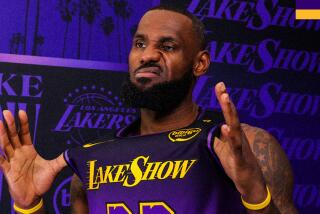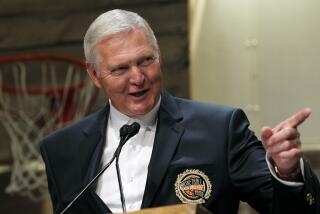They gotta have ART
- Share via
Bashfulness and bravery came together in a curious marriage as Ronny Turiaf strolled into a tattoo parlor in Spokane, Wash.
Turiaf, a Laker now and a Gonzaga Bulldog then, did not exactly know what to expect but knew it was for him.
He received his first tattoo five years ago. He left that parlor $100 shorter in cash and with the motto “Never Lose Faith” on his back.
“Once you get one it’s pretty addictive,” said Turiaf, who has since added several more tattoos, all serving as odes to his family. “It’s a matter of just putting something on your body that really means a lot.”
Today, one can watch an NBA playoff game and be treated to jumpers and alley-oops and tattoos -- lots and lots of tattoos. About 75% of NBA players have them.
“Guys are getting more and more,” Lakers guard Derek Fisher said. “It seems like whatever they had last year, the next year, you come back and they’re even more tatted up or marked up.”
The NBA’s population of about 450 players is primarily African American, but the distinctions of players and their tattoos may be more easily defined into cultural and generational terms than racial ones.
It wasn’t so long ago that tattoos in the NBA were deemed bizarre and odd from the days when Dennis Rodman turned himself into a walking palette of color.
Then in 1996 Allen Iverson joined the league. Iverson quickly turned into a scoring machine and his fame soared, and so did his tattoo collection, spreading to his neck, shoulders, arms, chest, and onto his left hand, which is inked with a dollar sign and the motto “Money Bagz”.
At the time, tattoos were still largely frowned upon by the league. Iverson’s tattoos were once airbrushed from the cover of an official NBA magazine. But Iverson was a trend-setter.
“He has a large following of people who look up to him and idolize him or whatever, and it becomes a competition of ‘I want to fit in. I want to be just like him’ and they just keep getting more and more tattoos,” said Lakers assistant coach Brian Shaw, who played with Iverson as a Philadelphia 76er in 1998.
Now, NBA players who don’t have a tattoo are in the ever-shrinking minority.
A decade ago, the Associated Press reported that 35% of NBA players were tattooed. Five years later that number had doubled, according to “In the Paint: Tattoos of the NBA and the Stories Behind Them,” a book detailing players and their tattoos.
Many tattoos are inspirational, bearing a credo or Bible passage to live by.
Shaquille O’Neal has a big “S” for Superman on his left biceps. A once clean-cut Kobe Bryant showed up one year with tribute tattoos to his wife and daughter on his left arm.
Other tattoos are deeply personal, and like Turiaf’s, tributes to family.
The Lakers’ Lamar Odom has a portrait of his son Jayden, who died two years ago while sleeping in his crib, on the side of his left chest and a portrait of his mother on his back.
Others are menacing -- portraits of the Grim Reaper or lions. Some tattoos are funny, such as that of former Jazz center Greg Ostertag of a dunking Fred Flintstone.
Jazz point guard Deron Williams, 23, is among those who keep adding to their body art. They include his daughters’ baby feet, names and birthdays, a cross with a rose in it and a basketball on his left biceps that reads “Texas made.”
“It’s a way to express yourself,” he said. “I probably won’t like them when I’m 90. But right now I do.”
In a sense, this reflects America’s society, where more than a third of people age 18 to 25 have tattoos, according to a Pew Research Center study.
But in that commonality, some of the goal of individuality may be lost.
“I think it’s just everybody trying to be like everybody else,” said Davy Sheets, a tattoo artist in Hampton, Va., who has inked Iverson. “At one time, people got tattoos to be different, now it seems like they get tattoos to be the same.”
While tattoos are popular among young American-born players, they are less so among Europeans in the NBA.
“European players are coming from a different culture and coming to an American game, and the tattoo is part of the American culture,” said Todd Boyd, a cultural studies professor at USC and author of “Young, Black, Rich and Famous: the Rise of the NBA, the Hip Hop Invasion, and the Transformation of American Culture.”
Said Lakers forward Vladimir Radmanovic, who hails from Serbia and is tattoo-free: “I just don’t see myself being 60 years old, walking my grandchildren down the street and having tattoo work on my arm. It looks nice on a young guy, but once you reach a certain age, it really doesn’t look nice anymore.”
To that extent, the tattoo rift is also felt among an older group of players who remain ink-less.
The reason, according to Shaw, who played in the NBA for 14 years and broke in with the Boston Celtics in 1988, is because his generation had its own new-age movement that threatened the status quo. It was earrings.
“I got [my ear] pierced during my rookie year when I was in Boston. I remember the guys on the team and the head coach making a lot of comments about me having an earring, but that was the big thing back in the ‘80s,” Shaw said.
Count Fisher, 33, among those players with tattoos.
He opted for small ones on his right arm about five years ago. One symbol stands for faithfulness. The other represents heart, mind and spirit. Both are for his wife, Candace.
And he got them in a spot that could be easily covered by a shirt depending where his life drifted after basketball.
But tattoos do still have some limits.
Al Thornton, a 24-year-old forward for the Clippers, came into the league without a tattoo. He doesn’t plan on getting one any time soon.
“If I get one, it would have to mean something,” he said. “I see a lot of guys getting one that doesn’t mean something and, also, people that are close to me really don’t have them.”
“He knows his mom,” said Philomenia Thornton. “We don’t do tattoos. Maybe one day, that might be something that might help him. People will look for someone clean cut with no tattoos and someone that listens to their mama.”
--
More to Read
All things Lakers, all the time.
Get all the Lakers news you need in Dan Woike's weekly newsletter.
You may occasionally receive promotional content from the Los Angeles Times.






